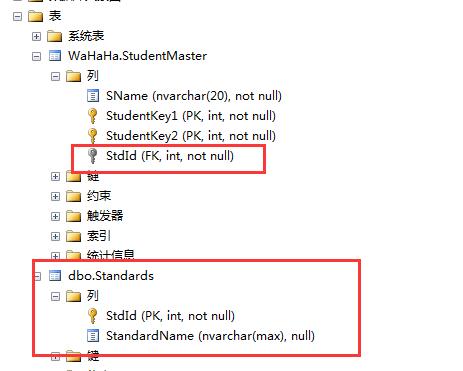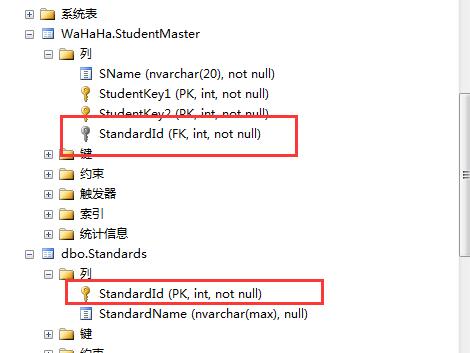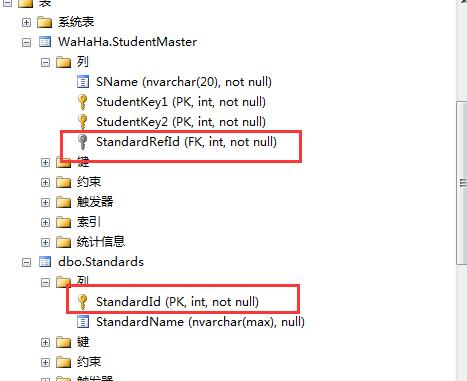7.9 数据注解特性--ForeignKey
外键特性,可以应用到类的属性中。Code-First默认的约定,对外键属性来说,假定外键属性的名称和主键属性是匹配的。
我们看一下,下面的代码:
using System;
using System.Collections.Generic;
using System.ComponentModel.DataAnnotations;
using System.ComponentModel.DataAnnotations.Schema;
using System.Linq;
using System.Text;
using System.Threading.Tasks;
namespace EF2
{
[Table("StudentMaster",Schema="WaHaHa")]
public class Student
{
[Key]
[Column(Order=)]
public int StudentKey1 { get; set; }
[Key]
[Column(Order=)]
public int StudentKey2 { get; set; }
[MaxLength()]
[ConcurrencyCheck]
[Required]
[Column(,TypeName="nvarchar")]
public string StudentName { get; set; }
[NotMapped()]
public int? Age { get; set; }
public int StdId { get; set; }
[ForeignKey("StdId")]
public virtual Standard Standard { get; set; }
}
}
using System;
using System.Collections.Generic;
using System.ComponentModel.DataAnnotations;
using System.Linq;
using System.Text;
namespace EF2
{
public class Standard
{
[Key]
public int StdId { get; set; }
public string StandardName { get; set; }
}
}

从上面的图中,可以看出,StdId在Student表中是外键,在Standard表中是主键。
这里是不是用类名+id的做法,使用外键。
默认的是使用这样的:
using System;
using System.Collections.Generic;
using System.ComponentModel.DataAnnotations;
using System.ComponentModel.DataAnnotations.Schema;
using System.Linq;
using System.Text;
using System.Threading.Tasks;
namespace EF2
{
[Table("StudentMaster",Schema="WaHaHa")]
public class Student
{
[Key]
[Column(Order=)]
public int StudentKey1 { get; set; }
[Key]
[Column(Order=)]
public int StudentKey2 { get; set; }
[MaxLength()]
[ConcurrencyCheck]
[Required]
[Column(,TypeName="nvarchar")]
public string StudentName { get; set; }
[NotMapped()]
public int? Age { get; set; }
public int StandardId { get; set; } //类名+ID
[ForeignKey("StandardId")]
public virtual Standard Standard { get; set; }
}
}
using System;
using System.Collections.Generic;
using System.ComponentModel.DataAnnotations;
using System.Linq;
using System.Text;
namespace EF2
{
public class Standard
{
[Key]
public int StandardId { get; set; } //类名+ID
public string StandardName { get; set; }
}
}

看看下面的:
using System;
using System.Collections.Generic;
using System.ComponentModel.DataAnnotations;
using System.ComponentModel.DataAnnotations.Schema;
using System.Linq;
using System.Text;
using System.Threading.Tasks;
namespace EF2
{
[Table("StudentMaster",Schema="WaHaHa")]
public class Student
{
[Key]
[Column(Order=)]
public int StudentKey1 { get; set; }
[Key]
[Column(Order=)]
public int StudentKey2 { get; set; }
[MaxLength()]
[ConcurrencyCheck]
[Required]
[Column(,TypeName="nvarchar")]
public string StudentName { get; set; }
[NotMapped()]
public int? Age { get; set; }
public int StandardRefId { get; set; }
[ForeignKey("StandardRefId")]
public virtual Standard Standard { get; set; }
}
}
using System;
using System.Collections.Generic;
using System.ComponentModel.DataAnnotations;
using System.Linq;
using System.Text;
namespace EF2
{
public class Standard
{
[Key]
public int StandardId { get; set; }
public string StandardName { get; set; }
}
}
看数据库:

这个意思就是,我们可以随便指定外键的名称,哈哈哈哈哈。。。
7.9 数据注解特性--ForeignKey的更多相关文章
- 9.5 翻译系列:数据注解之ForeignKey特性【EF 6 Code-First系列】
原文链接:https://www.entityframeworktutorial.net/code-first/foreignkey-dataannotations-attribute-in-code ...
- 7.7 数据注解特性--Table
大家可能注意到,有几个特性,我没有翻译,因为实在是太简单了,看一下就知道,之前也学过,现在只是系统学一下,所以就粗略的看一下就行了. 现在学习数据注解特性的--Table特性. Table 特性可以被 ...
- 9.10 翻译系列:EF数据注解特性之StringLength【EF 6 Code-First系列】
原文链接:https://www.entityframeworktutorial.net/code-first/stringlength-dataannotations-attribute-in-co ...
- 9.9 翻译系列:数据注解特性之--MaxLength 【EF 6 Code-First系列】
原文链接:https://www.entityframeworktutorial.net/code-first/maxlength-minlength-dataannotations-attribut ...
- 9.7 翻译系列:EF数据注解特性之--InverseProperty【EF 6 Code-First系列】
原文链接:https://www.entityframeworktutorial.net/code-first/inverseproperty-dataannotations-attribute-in ...
- 9.3 翻译系列:数据注解特性之Key【EF 6 Code-First 系列】
原文链接:http://www.entityframeworktutorial.net/code-first/key-dataannotations-attribute-in-code-first.a ...
- 9.2 翻译系列:数据注解特性之---Column【EF 6 Code First系列】
原文链接:http://www.entityframeworktutorial.net/code-first/column-dataannotations-attribute-in-code-firs ...
- 9.翻译系列:EF 6以及EF Core中的数据注解特性(EF 6 Code-First系列)
原文地址:http://www.entityframeworktutorial.net/code-first/dataannotation-in-code-first.aspx EF 6 Code-F ...
- 9.1 翻译系列:数据注解特性之----Table【EF 6 Code-First 系列】
原文地址:http://www.entityframeworktutorial.net/code-first/table-dataannotations-attribute-in-code-first ...
随机推荐
- .NET面试题系列[0] - 写在前面
.NET面试题系列目录 .NET面试题系列[1] - .NET框架基础知识(1) .NET面试题系列[2] - .NET框架基础知识(2) .NET面试题系列[3] - C# 基础知识(1) .NET ...
- ABP框架理论学习之后台工作(Jobs)和后台工作者(Workers)
返回总目录 本篇目录 介绍 后台工作 后台工作者 让你的应用程序一直运行 介绍 ABP提供了后台工作和后台工作者,它们会在应用程序的后台线程中执行一些任务. 后台工作 后台工作以队列和持续的方式在后台 ...
- Android 知识杂记(MVP模式)
MVP的模式在于将原来activity中业务逻辑的部分剥离出来,代码示例如下: Account public class Account { private String mUsername; pri ...
- 剑指Offer面试题:20.栈的压入、弹出序列
一.题目:栈的压入.弹出序列 题目:输入两个整数序列,第一个序列表示栈的压入顺序,请判断第二个序列是否为该栈的弹出顺序.假设压入栈的所有数字均不相等.例如序列1.2.3.4.5是某栈的压栈序列,序列4 ...
- ASP.NET MVC 路由(四)
ASP.NET MVC路由(四) 前言 在前面的篇幅中我们讲解路由系统在MVC中的运行过程以及粗略的原理,想必看过前面篇幅的朋友应该对路由有个概念性的了解了,本篇来讲解区域,在读完本篇后不会肯定的让你 ...
- [ASP.NET MVC 小牛之路]03 - Razor语法
本人博客已转移至:http://www.exblr.com/liam Razor是MVC3中才有的新的视图引擎.我们知道,在ASP.NET中,ASPX的视图引擎依靠<%和%>来调用C#指 ...
- 【VC++技术杂谈008】使用zlib解压zip压缩文件
最近因为项目的需要,要对zip压缩文件进行批量解压.在网上查阅了相关的资料后,最终使用zlib开源库实现了该功能.本文将对zlib开源库进行简单介绍,并给出一个使用zlib开源库对zip压缩文件进行解 ...
- [笔记]linux下和windows下的 创建线程函数
linux下和windows下的 创建线程函数 #ifdef __GNUC__ //Linux #include <pthread.h> #define CreateThreadEx(ti ...
- sql的行转列(PIVOT)与列转行(UNPIVOT)
在做数据统计的时候,行转列,列转行是经常碰到的问题.case when方式太麻烦了,而且可扩展性不强,可以使用 PIVOT,UNPIVOT比较快速实现行转列,列转行,而且可扩展性强 一.行转列 1.测 ...
- ComboTree 的json格式和引用
在easyui内,用 <select>实现combotree. <td ><select class="easyui-combotree" url=& ...
